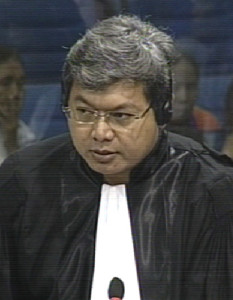Division 310 Soldier Testifies on Arrests and Coup d’Etat Plans
Today, Civil Party Mon Vun concluded her testimony that had begun on Friday last week. She was questioned by the defense teams on issues relating to the loss of her children and husband. Next, witness Sem Om took his stance and told the court about his role in Division 310, arrests that were conducted, as well as a potential plan to topple the Democratic Kampuchea government.
Back to Civil Party Mom Vun

Civil Party Mom Vun
International Civil Party Lead Co-Lawyer Marie Guiraud was absent due to personal reasons. The testimony of Civil Party Mom Vun then continued where she had left off last Friday. Nuon Chea Defense Counsel Liv Sovanna asked about the death of her children and asked whether any of her children died, besides the twins in 1982. She said that four of her children died after 1979. Her father died in 1975. Her mother became sick and died in late 1975. She did not have any aunts, because her aunts were “elderly and died”. He said that she had told the investigators that six of her children died during the Khmer Rouge regime, whereas she had told the court, he said, that only two died.[1] She replied that her statement seemed not to correspond to what she had said before. She then said that two children died after the Khmer Rouge regime.
Clarification on Civil Party Application
He read an excerpt of her Victim Information Form, in which she had said that she left her children under her mother’s care in 1976.[2] She answered that elderly women took care of her children. They were called mothers and fathers.
He then inquired about her first husband Tan Him and conflicting information of her testimony and her Victim Information Form.[3] She had said that he was taken away in 1975, while she indicated that he still climbed palm trees in October 1975.[4] She explained that she returned to her village in 1977, but that her husband had been taken away in 1975. He said that she had indicated in her form that her husband still climbed palm trees in January 1977. She insisted that her husband was arrested in 1975.[5]
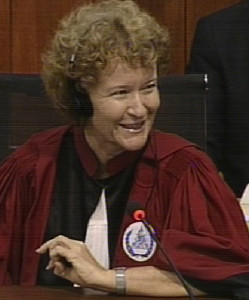
Judge Claudia Fenz
Ms. Chen asked why she had not mentioned that her parents died during the Khmer Rouge regime, but had instead listed other relatives and students called Ron, Ry, and Ryt. [6] Judge Claudia Fenz highlighted that she had mentioned in the last paragraph that her parents died in her Civil Party Application. When Ms. Chen rephrased her question, Ms. Vun replied that she had included her parents in her application form, but that this might have been in an earlier form. Ms. Chen asked why she did not specify the loss of her first husband in the Civil Party Application. She answered that her first husband was called to a study session in 1975.
Civil Party Lawyer Pich Ang interjected and said that the questions were not appropriate. “By asking why it’s a blame to the Civil Party. The Civil Party is not very educated and she is not able to verify the discrepancy in the documents”. Since she was illiterate, she had not re-read the document before thumb-printing it. Ms. Chen asked why she had not specified the loss of her children in the form either. Mr. Ang objected and said the question was repetitive. She explained that she did not include the loss of her last husband, because she did not recall his loss at the time. As for her children, she said that two of her children died in 1977. Mr. Sovanna took the floor and said that the Civil Party Application did not specify the loss of her parents.
The Khieu Samphan Defense Team did not have any questions for the Civil Party.
The Civil Party then proceeded to make her Civil Party Impact Statement.
Civil Party Impact Statement
National Civil Party Lead Co-Lawyer Pich Ang
The suffering that I experienced during the Khmer Rouge is that I had to work hard, I did not have enough food to eat. I was asked to mix the chemicals in order to mix the chemicals in order to make the fertilizer […] and then I was asked to taste the fertilizer. One day I was asked to do the transplanting and there were leaches […] seeing that they used a long stick to push me into the water and I still have a scar on my body. One day I had blood out of my mouth and I was accused that I was pretending to be ill. I was also forced to get married. Two days before the day of my marriage, five people took me away and raped me. Two days later I was forced to get married and I was also forced to consummate my marriage. It is a shame to me. […]
Now I’m telling the court about my suffering. It is a shame, as I said. After the marriage, I was forced to consummate the marriage. I had been raped, I was looked down upon by others. I had pain in my life, nothing could compare. Even if I died I still remember the suffering […]. In addition, I would like to ask how could the two accused compensate what I have lost, and also the Cambodian people. […] Last but not least I would like to express my thanks to your honors […]. That’s all I have to say.
New Witness: Sem Om
Witness Sem Om (2-TCW-1031), alias Prum Eab lives in Doung Commune in Kampong Thom Province
Having been requested to be called by the Defense Team for Nuon Chea, the floor was first granted to this team. Victor Koppe asked whether, when referring to “one interview” that he had given, he was referring to an interview he had given to a foreign woman, which the witness confirmed. He wanted to know whether he recalled Pam Sochat who interviewed him for DC-Cam. He said that this was the case and that it was audio-recorded. They read out the transcript to him. Mr. Koppe asked whether it was correct that one point in time he was village chief. Mr. Om said that he was still the village chief of his village. He was elected into this office. He will run for office in the next elections.
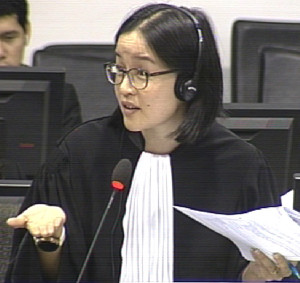
Nuon Chea Defense Counsel Doreen Chen
At this point, the President adjourned the hearing for a break.
After the break, Mr. Koppe asked whether he would run for the CNRP or the CPP in the next elections. The election was prohibited by the presiding judge, who said that the question was outside the scope of the trial.
Division 310
The witness entered the revolution in 1973 in Kampong Thom Province. He was part of Division 1 and Battalion 502. It became Division 310 after the liberation of Phnom Penh. To Him Hon was the commander of Regiment 13. He was a messenger of the team. Mr. Koppe asked whether it was accurate that he was a low-ranking soldier, which he confirmed. Mr. Koppe also asked about his interview, in which he had said that he was in charge of the logistic office and that he knew Koy Thuon, alias Khuon.[7] At this point, he had already become part of Division 310. Ta Oeun was part of Division 310 and a commander.[8] Koy Thuon was higher in rank than Oeun in terms of the military.
He did not know an individual called Sot (or Sop). Mr. Koppe asked whether he knew who was in charge of District 106 in 1976 and 1977. Mr. On could still not remember. Neither could he recall when Ta Oeun was promoted.[9]
The witness confirmed that he was stationed close to Wat Phnom, Psar Thmei and the Calmette Hospital. They were also stationed at three other locations, including Tuol Kork. He was in charge of economic affairs, which meant to deliver rice to soldiers. At the Vietnamese border he was in charge of the radio communication system and would report the situation at the rear battlefield.
He was at Trapeang Thlong in Tboung Khmum District. Mr. Koppe asked whether he remembered a location called Me Moth.[10] The radio system was stationed at Lor Kchung, whereas he was stationed at Trapeang Thlong. He had never heard of the location Boeung Kok. It was Boeung Kork, he corrected, in Trapeang Kork. They were instructed not to engage in war so as to not kill Khmer people.
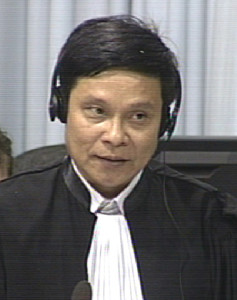
Nuon Chea Defense Counsel Liv Sovanna
Vietnamese Troops
He never contacted the Vietnamese troops directly. “I turned on the radio and I heard one insulted the other”. He did so accidentally. He heard the instruction that “we needed to lay down the weapons and we were told to go back to the rear to take care of our parents, since our parents were allegedly killed.” He believed the situation at the time, but did not know where to flee to. He heard Khmer people speaking to Khmer people. He did not understand Vietnamese. Mr. Koppe asked whether he knew if Hun Sen was part of the North Zone forces. He replied that he did not know this back then. The artillery unit – that he belonged to – were separate from the other units. They could overhear the radio from the Vietnamese side. The person who spoke on the radio was radio and spoke about the killing of their parents.
Oeun was called to receive guests and disappeared then. A messenger said that he probably was arrested. They played an audio record at Wat Phnom and he heard the sound of Chen. “They said that they were our fathers and mothers and that they all had been arrested and chained”. He could not recall clearly where Oeun was sent to. Mr. Koppe refreshed his memory with his interview, in which he had mentioned the Chinese Embassy.[11] He confirmed this, but said that he did not know where it was located at the time. Mr. Koppe said that a witness had said that Oeun was invited to the Korean Embassy, and not the Chinese Embassy.[12] He replied that he only heard that he was taken to the Chinese Embassy.
Mr. Koppe asked whether he had heard of a plan to topple Pol Pot. Mr. Om confirmed this: “I knew that Oeun had planned to agitate the people”, he said. He recounted that equipment was prepared at various parts of a unit. The plan was to change uniforms and camouflage to attack. This was at the time that he was stationed at Wat Phnom. The usual uniform was black, he said, but they had prepared one room in which they set up uniforms in sets, such as military uniforms. It was the same uniform as the one worn by the paratroops. “However, the quality of the uniform was not that great”.
When he was near Psar Thmei, he saw them arrange the uniforms. At this time, his base was elsewhere. The uniforms were made in the United States, he said. They were given to the Lon Nol army beforehand. He did not know where they received these uniforms from and only saw them arrange these uniforms. Mr. Koppe asked where he saw he weapons he had mentioned. He answered that he did not know about the weapons for the infantry. However, the artillery unit Regiment 13 had different sets of weapons.
Arrests
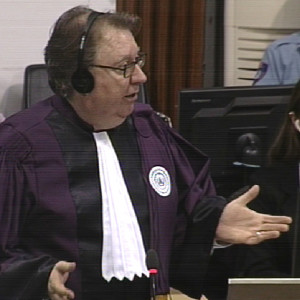
International Senior Assistant Prosecutor Dale Lysak
Oeun was arrested afterwards. Following this, chiefs and cadres were arrested and the plot did not materialize. He did not know anything about secret documents that laid out US assistance. To refresh his memory, Mr. Koppe read an excerpt of his statement, in which he had said that he secretly read a typed document setting out that the U.S. would come for assistance within 24 hours.[13] He recalled having said this to investigators of DC-Cam. He specified that he did not see the document himself but that he heard other people talk about these documents. When Mr. Koppe said that he had said in his DC-Cam statement that he read the documents and asked where this was, International Senior Assistant Co-Prosecutor Dale Lysak objected and said that he could confront him with the statement again, but that he had explicitly said that he had not read it. Mr. Koppe rephrased the question. Mr. Om insisted that he had not physically read the document and that he heard about it from other people. He heard from Ta Oeun’s messenger that it was a typed document and bore no signature.
Mr. Koppe asked whether he was aware of any special relation between Ta Oeun and the United States, which the witness denied. Mr. Koppe read an excerpt of another Division 310 combatant. This combatant had said that the North was affiliated with the U.S., while the East was affiliated with the yuon and the Southwest was on the side of the Khmer Rouge.[14] Mr. On said that he was unable to react to this and that he did not know anything about this. He did not know what Oeun’s prior military position would have been. “With my limited capacity I was not allowed to go anywhere near him”.
The President took the opportunity to call for a break.
Coup d’état
After the lunch break, Mr. Koppe said that they listened to the audio recording of the witness’s interview with DC-Cam. They would play the extract where he had said that he saw the document.
Mr. Koppe then read what another combatant had said about Oeun. He had said that he did not believe that Ke Pauk had any connections with the Americans, but that Oeun might have had some, because he was a former captain of the old regime.[15] The witness did not know about this. He heard that Koy Thuon was arrested before Oeun’s arrest.[16] He did not witness the arrest himself. He said that he did not know where he was arrested, nor other details, because he was “simply a rank-and-file soldier”. The other combatant had said that Hun Sen was in the “same clique” as Oeun.[17] As quoted in Ben Kiernan’s book, Hun Sen had said that Koy Thuon was “placed under house arrest near the independence monument”.[18] He answered that he never heard about it. He said he did not know about the arrest.[19] Mr. Koppe asked whether the arrest of Koy Thuon could have taken place on 21 January 1977 and the one of Oeun around February 1977. Judge Jean-Marc Lavergne asked for reference. Mr. Om could not recall the month. He saw them packing up the clothes five months before the arrest. Mr. Koppe asked whether it was possible that it was in September 1976. He replied that he did not know, because there were no calendars at the time.
Mr. Koppe said that “there is quite some evidence” as to the date of when this “plot was supposed to take place”. Mr. Koppe gave a few references and wanted to know whether he heard anyone say when this coup d’état was supposed to take place at the meeting when Koy Thuon’s confession was played.[20] He replied that the coup d’état was not mentioned.
He then requested to be able to play the excerpt of the audio-tape of the interview. There was a brief discussion that the tape would have to be admitted onto the case file, which it was. He said the voice “sounded familiar” but that he could not remember having been presented any document.
Mr. Koppe then asked about potential attacks on Pochentong airports, which the witness had not heard about. Despite being presented with another witness’s account, he said that he did not know about a planned attack on Pochentong. Mr. Koppe read another excerpt of a witness’s statement, who had talked about an attack on Pochentong Airport.[21]
They were instructed not to attack the Vietnamese side, because many Cambodian people had already been killed. He could hear the exchange between Vietnamese and Khmer speaking people. “Sometimes they scolded one another”. The Vietnamese side had a different radio station.
Mr. Koppe quoted Kiernan in whose book a plan to go to the Vietnamese side was mentioned. He replied that he heard a Khmer voice saying on the channel that they should join hands to topple Pol Pot. “They were Khmer from the Vietnamese side”.
Mr. Koppe asked whether he was ever involved in stealing food and cattle, which the witness denied. Mr. Koppe asked whether the name Richard Messler meant anything to him. He said that he did not know.
At this point, the President adjourned the hearing for a break.
Questions by the Co-Prosecution

Nuon Chea Defense Counsel Victor Koppe
After the break, Mr. Lysak started his line of questioning for the Co-Prosecution. He asked the witness to tell the court at what time he was sent to the Eastern Battlefront. He said that it was in late 1977 or early 1978. “It was in a cold season”. He heard a broadcast about a month before they entered the country. “It was perhaps in mid-August or early September when I heard about the broadcast. There was a fraction in the unit and at the time I was fleeing through the forest”. He confirmed that this was his biography.[22] However, he could “not read it well”. He said that it was “perhaps correct” that he became a member of the youth league in Prey To Ting in Kampong Cham Province in July 1977.
He was in Battalion 13, which was initially a regiment. This happened in early 1977 after they were reassigned and “some members disappeared”. He was assigned to the area of Kok Sro. He did not know where other soldiers were reassigned to. There were 500 soldiers initially, but the number was reduced to 300 and subsequently reduced even further. There were Battalions 13 and 15, and another one whose number he could not recall. He stayed in the area for “quite a long time” and stayed at three different locations there. While he was based at Chruy Chong Va, he was part of the messenger unit. The rest was assigned to do rice farming. On 17 April 1975, he entered Phnom Penh to stand guard at Wat Phnom. He was then sent to stand guard at Chres.
They cleansed the city “immediately after we took Phnom Penh”.[23] The three “longhaired soldiers” came out from hiding after three days when they cut off electricity and water. He saw both wounded soldiers and the three longhaired soldiers killed. The Nuon Chea Defense Counsel objected and argued that these questions had not been permitted to the Nuon Chea regarding an earlier witness. The objection was overruled. He assumed that they were Lon Nol soldiers from their appearance.
He worked for Him Horn as a messenger. Ron questioned the “longhaired soldiers” and told them to cross the river. He then heard gunshots and asked Ron where they were sent to. Ron replied that they were “sent by the river”. He did not know the people who pushed the other soldiers off the bridge. “They were probably part of the infantry”.
Mr. Koppe interjected and referred to a decision by the Presiding about asking questions to the treatment of Lon Nol soldiers during the evacuation of Phnom Penh. He said that bench should be consistent in its rulings.
Him Horn
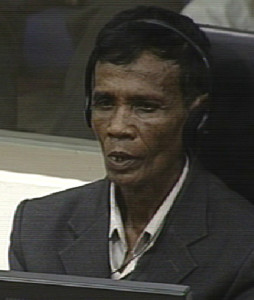
Witness Sem On
He was sent to a battlefront at National Road 6 when Him Horn called him to work as a messenger. Mr. Lysak presented a List of Participants of October 1976 Study Session to the witness that showed representatives of Division 310. [24] He confirmed that Horn was the one he worked for as a messenger. Mr. Lysak asked whether he remembered the person named Song. Mr. Lysak said that he had said that Horn was accused of being a traitor.[25] Mr. Om confirmed that he had heard this. He rode his motorcycle into a parked vehicle and committed suicide. He broke his neck. “The situation was chaotic and some people shot themselves dead”.
Mr. Lysak presented lists of S-21 prisoners to the witness.[26] He explained that there were two Horns and that he did not know Han. The full name of Horn was Him Horn. He said he was sure that this person died and buried at Russei Kao. He was not allowed to accompany those who buried him, but he heard this from his messengers. His messenger was called Nhim. He had told him that the witness’s supervisor told him that he broke his neck when crashing into a vehicle.
He attended a meeting in which over a thousand soldiers participated. The person who presided over the meeting was a male called Ta Khieu. It took place in a building with an iron roof.
There was a discussion about using confessions, after Mr. Lysak had asked how the regime had used them. Mr. Lysak explained that it went not to the truth of the confessions, but to the way it was used for.
He heard the sound of shackles and the content of confessions. He heard “your parents all died. Please do not think about them and go back to work”. Mr. Lysak read an excerpt of the interview of the witness. After this, a recording was played. Mistreatment was not mentioned. “They wanted us to hear and know, and warned us not to do what he did. We were told that we had no longer parents. They wanted us to listen to the recording. Our rights were deprived from us after that. We were used on a daily basis to do the field.” They were told that those people who were arrested were sent for re-education. They did not tell them that they were arrested but that they were sent to re-education. Half a month later, they did not return either. He had to go to a session in Phnom Penh. “I was so scared”. At this time he was farming rice for three or four months before being called to Phnom Penh. “I had no idea of their plan.”
He went to the divisional head office and he was trained how to use the radio communication system. He was sent to fight the Vietnamese later, but was not given any weapons. Some of his colleagues said that they could do everything they were assigned to do as long as they were given rice. They were given weapons on a truck. He was reassigned to help cultivate the rice with local people and trained in military matters for three months. He was then told to reinforce other forces. In the end he returned to Puom Pol, before he was sent again for fighting.
The President adjourned the hearing. It will continue tomorrow, September 20, 2016, at 9 am.
[1] E3/735, at 01003348 (KH), 01074568 (EN), 01112077 (FR).
[2] E3/6307, at 00532025 (KH), 01168544 (EN), 01137823 (FR).
[3] E3/6307, at 00532025 (KH), 01168544 (EN), 01137822 (FR).
[4] ibid.
[5] E3/6307, at 00532026 (KH), 01137824 (FR), no English translation of this page.
[6] E3/6307.
[7] E3/7523, at 00875566-67 (EN), 00884226-27 (FR), 00061156-57 (KH).
[8] E3/5149, at 00205044 (EN), 00170633 (KH), 00524397 (FR).
[9] E3/7523, at 00875665 (EN), 00061155 (KH), 00884225 (FR).
[10] E3/7523, at 00875554 (EN), 00061147 (KH), 00884217 (FR).
[11] E3/7523, at 00875576 (EN), 00885234 (FR), 00061165 (KH).
[12] E3/5641, at 00881783 (EN), 00055140 (KH), 00892737 (KH).
[13] E3/7523, at 00875575 (EN), 00061164 (KH), 0088433 (FR).
[14] E3/5641, at 0081777 (EN), 00055134-35 (KH), 00892731 (FR).
[15] E3/2073, at 00876433 (EN), 0005210 (KH), 00892884 (FR).
[16] E3/7523, at 00875577 (EN), 00061166 (KH), 00884234-35 (FR).
[17] E3/7583, at 00876559 (EN).
[18] E3/1593, at 01150169 (EN), 00639102 (FR), 00637857 (KH).
[19] E3/2117, at 00081344 (EN), 00192975 (KH), no French translation available.
[20] At 00639181 (FR), 00637879-80 (KH); E434: F2/8.1.29.
[21] 00282217 (EN), 00270159 (KH), 00285597-98 (FR).
[22] E3/7523, at 00058077 (KH).
[23] E3/5139, at 00170633-34 (KH), 00205044 (EN), 00524398 (FR).
[24] E3/1585, at 00095533-34 (KH), 00897650 (EN), 00611637 (FR).
[25] At 00170634 (KH), 00205044 (EN), 00524398 (FR).
[26] E3/9843, at 0101004 (KH); E3/2285, at 0009199-200 (KH), 00873411 (EN).
Featured Image: Witness Sem On (Flickr).

